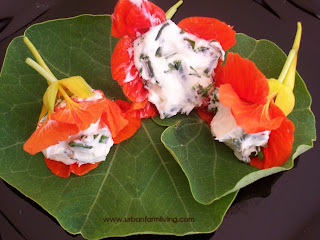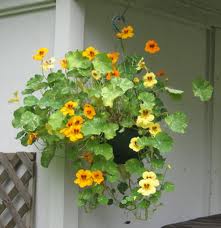Most of the info here was taken from http://gardening.about.com/od/plantprofiles/p/Nasturtium.htm
http://lizzieslogic.blogspot.com/2010/06/plant-of-week_18.html
ABOUT:
Nasturtiums are loved for their rich, saturated jewel-toned colors. They are fast and easy to grow and, in fact, do best with a little neglect. There are varieties for almost every gardening purpose: bushy plants for borders and edges, trailing plants for walls and containers and climbers to add dramatic height in a garden. The leaves and flowers are edible, with a peppery tang, and even the seed pods are used as a substitute for capersThey are great companion plants as
well. Nasturtiums help deter aphids, whiteflies, squash bugs, cucumber beetles
and other pests. Plant them with tomatoes, radishes, cabbage, cucumbers, and
under fruit trees. They come in vibrant colors, or muted tones-variegated leaves
or plain-and some are fairly dwarfed while others can be used as a vine,
climbing five foot or more.
Varieties:
 |
| Huge Nasturium Vines To see article go here |
- Alaska Series - Bushy, dwarf plants with heavily variegated foliage and the blossoms are held above the foliage.
- Jewel Series - Bushy, dwarf with double and semi-double blooms. A profuse bloomer, but flowers can tend to get lost under the foliage.
- 'Peach Melba' - Busy, dwarf with semi-double buttery yellow flowers splashed with orangy-red centers. Good for containers.
- 'Canary Creeper' (T. Peregrinum) - Perennial vines with yellow flowers that look like bird’s wings.
Uses
Use the blossoms either whole or chopped to decorate creamy soups, salads, butters, cakes and platters. Their sweet, peppery taste adds to the enjoyment. Plus, it's not just the flowers and buds that are packed with a zippy flavor; the young leaves are tender and edible as well. Nasturtiums are popular with chefs and home gardeners because their colorful flowers not only dress up a plate, they're high in vitamins A, C (10 times as much as lettuce), and D.
 |
| This looks so good! Nasturtiunn with cream cheese and chives |
Nasturtiums are usually started from seed. Soak the seeds in warm water overnite. It also helps to nick the outer shell with a small knife. The seeds germinate quickly and the plants will be up and blooming in little time. Seeds can be sow directly in the garden, when the soil has warmed, or started indoors about 2-4 weeks earlier. Nasturtiums don’t especially like being transplanted, so starting indoor seedlings in peat pots will reduce transplant shock. Once planted, they tend to take care of themselves. Alternatively,. Sow seeds 10 to 12 inches apart in the garden about a week before the last frost date for your area. In all but the richest soils, amend the planting area by mixing in a 1-inch layer of compost. Plants shouldn't need supplemental fertilizing during the growing season
Once they are established, nasturtiums will continue to spread and bloom until the first frost, with very little work or water from you. They will grow in partial shade but you will get mostly foliage as they don't flower as well in those conditions as they do in their preferred full sun location.They love cool, damp, well-drained soil. If plants begin to flag in the heat of summer, cut them back and they'll regrow and flower again when cooler weather arrives in fall.
Do best in well drained soil.
Harvest
For salads, harvest nasturtium flower buds, flowers, and young leaves in the cool of the morning when flowers have just opened. The more heat-stressed the plant, the more pungent the leaves and flowers will taste. Gently wash and dry the flowers and leaves and use immediately or store in a plastic bag in the refrigerator. Although you can eat the whole flower, if the flavor is too strong use only the milder-tasting petals.
Cheat Sheet
1. Flowers are edible with a peppery taste, see above pics
2. Fast and easy to grow
3. Can be grown in the garden or in a container or hanging basket
4. Available as a dwarf plant or climbing vine
5. Deter bugs
5. Good companion plant for tomatoes, cucs, cabbage, radishes
6. Poor soil conditions, lots of sun,
7. Too much shade will give you mostly leaves
8. Nick and soak overnight
9. Start indoors 2 weeks before you are going to plant
10. Moonlight pastel yellow vine
11. No fertilizer
12. Water once a week
13. If they start dying in summer heat, cut back and they will rebloom in fall
14. If starting inside, use peat pots
10. Moonlight pastel yellow vine
11. No fertilizer
12. Water once a week
13. If they start dying in summer heat, cut back and they will rebloom in fall
14. If starting inside, use peat pots









